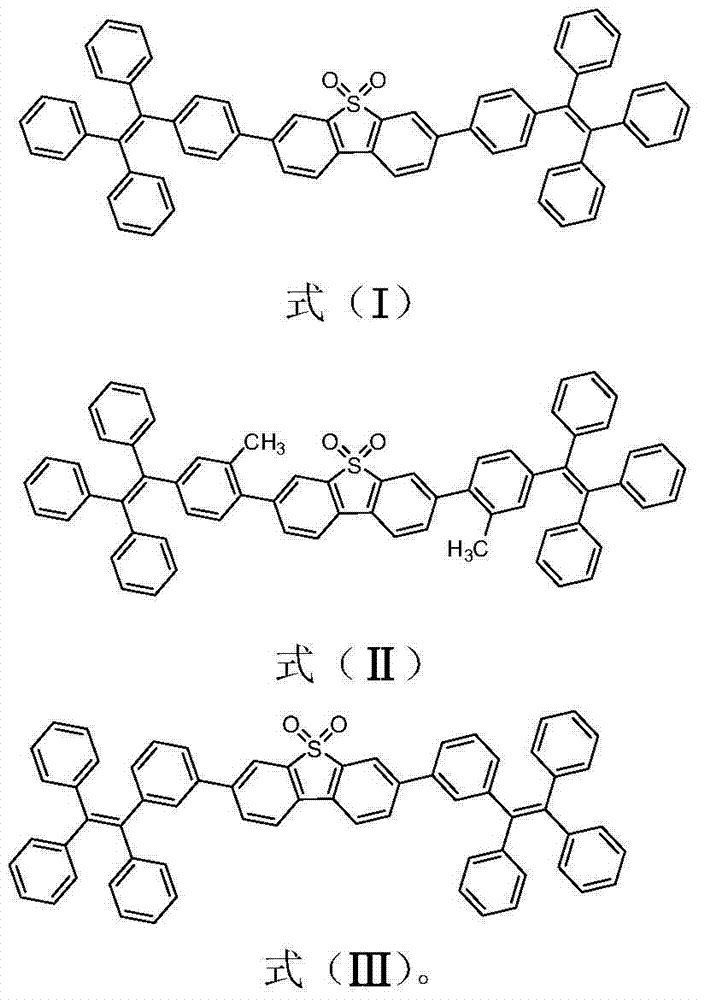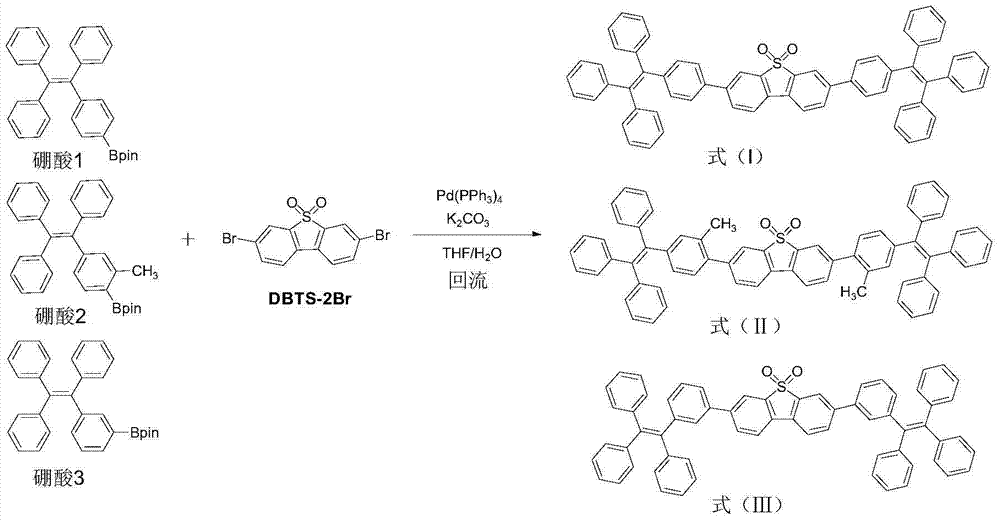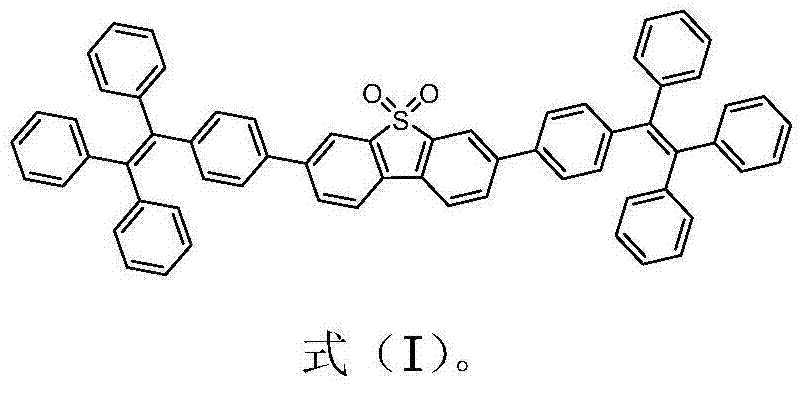Aggregation-induced emissive blue-ray molecule by construction of dibenzothiophene sulfone unit as well as preparation method and application of aggregation-induced emissive blue-ray molecule
A technology of aggregation-induced luminescence and dibenzothiophene sulfone, which is applied in the fields of luminescent materials, chemical instruments and methods, semiconductor/solid-state device manufacturing, etc.
- Summary
- Abstract
- Description
- Claims
- Application Information
AI Technical Summary
Problems solved by technology
Method used
Image
Examples
Embodiment 1
[0026] Add compound 3,7-dibromodibenzothiophene sulfone (100 mg, 0.27 mmol), boronic acid 1 (306 mg, 0.67 mmol), potassium carbonate (740 mg, 5.4 mmol) and a catalytic amount of Pd in a Schlenk tube under nitrogen atmosphere. (PPh 3 ) 4 , and then added toluene (8 mL), ethanol (1.5 mL) and deoxygenated water (3.3 mL), stirred at 90° C. for 24 hours to fully react. After the reaction was completed, the product was cooled to room temperature, extracted with toluene, and the organic phase was collected and washed with anhydrous Na 2 SO 4 Dry to obtain crude product. Using petroleum ether and dichloromethane (v / v, 2 / 1) as eluents, the product was separated and purified by silica gel column chromatography, and dried in vacuo to obtain a green solid (205 mg, yield 87%), which was used with 1 H NMR, 13 C NMR, MS and EA characterize the structure, confirming that the green solid has the structure shown in formula (I).
[0027] 1 H NMR (300MHz, CDCl 3 )δ(ppm):7.98(s,2H),7.81(...
Embodiment 2
[0030] Add compound 3,7-dibromodibenzothiophene sulfone (100 mg, 0.27 mmol), boronic acid 2 (315 mg, 0.67 mmol), potassium carbonate (740 mg, 5.4 mmol) and a catalytic amount of Pd in a Schlenk tube under nitrogen atmosphere. (PPh 3 ) 4 , and then added toluene (8 mL), ethanol (1.5 mL) and deoxygenated water (3.3 mL), stirred at 90° C. for 24 hours to fully react. After the reaction was completed, the product was cooled to room temperature, extracted with toluene, and the organic phase was collected and washed with anhydrous Na 2 SO 4 Dry to obtain crude product. Using petroleum ether and dichloromethane (v / v, 2 / 1) as the eluent, the product was separated and purified by silica gel column chromatography, and dried in vacuo to obtain a light green powder (183 mg, yield 75%), which was mixed with 1 H NMR, 13 The structure was characterized by C NMR, MS and EA, which confirmed that the light green powder had the structure shown in formula (II).
[0031] 1 H NMR (300MHz, ...
Embodiment 3
[0034] Add compound 3,7-dibromodibenzothiophene sulfone (100 mg, 0.27 mmol), boronic acid 3 (306 mg, 0.67 mmol), potassium carbonate (740 mg, 5.4 mmol) and a catalytic amount of Pd in a Schlenk tube under nitrogen atmosphere. (PPh 3 ) 4 , and then added toluene (8 mL), ethanol (1.5 mL) and deoxygenated water (3.3 mL), stirred at 90° C. for 24 hours to fully react. After the reaction was completed, the product was cooled to room temperature, extracted with toluene, and the organic phase was collected and washed with anhydrous Na 2 SO 4 Dry to obtain crude product. Using petroleum ether and dichloromethane (v / v, 2 / 1) as the eluent, the product was separated and purified by silica gel column chromatography, and dried in vacuo to obtain a white powder (194 mg, yield 82%), which was used with 1 H NMR, 13 The structure was characterized by C NMR, MS and EA, and it was confirmed that the white powder had the structure shown in formula (III).
[0035] 1 H NMR (300MHz, CDCl 3 )...
PUM
| Property | Measurement | Unit |
|---|---|---|
| Current efficiency | aaaaa | aaaaa |
| Current efficiency | aaaaa | aaaaa |
Abstract
Description
Claims
Application Information
 Login to View More
Login to View More - Generate Ideas
- Intellectual Property
- Life Sciences
- Materials
- Tech Scout
- Unparalleled Data Quality
- Higher Quality Content
- 60% Fewer Hallucinations
Browse by: Latest US Patents, China's latest patents, Technical Efficacy Thesaurus, Application Domain, Technology Topic, Popular Technical Reports.
© 2025 PatSnap. All rights reserved.Legal|Privacy policy|Modern Slavery Act Transparency Statement|Sitemap|About US| Contact US: help@patsnap.com



